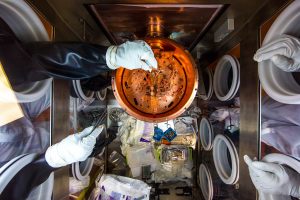
Neutrinos are very small particles which react weakly with mass. Measuring their reactions involves an environment with incredibly low background radiation and interference. The MAJORANA Demonstrator experiment is a collaboration of 129 researchers from 27 institutions and 6 countries which seeks to better understand these particles. UNC Physics and Astronomy faculty members John Wilkerson and Reyco Henning are both involved in this research, along with department Senior Research Scientist Mark Howe (as well as many graduate students and postdoctoral scholars). The experiment seeks to observe neutrinoless double-beta decay in atomic nuclei, which would demonstrate that neutrinos are their own antiparticles and offer greater insight into our understanding of the universe.
A study published in Physical Review Letters outlines how the MAJORANA collaboration has been able to successfully shield a germanium detector array from background radiation. This is exciting news that opens the door to creating a larger-scale experiment to study the nature of neutrinos. For more information, see articles from the UNC College of Arts & Sciences and Oak Ridge National Laboratories. Further reading can also be found in a recent APS article written by UNC Physics and Astronomy Professor Jon Engel and Petr Vogel of California Institute of Technology.

